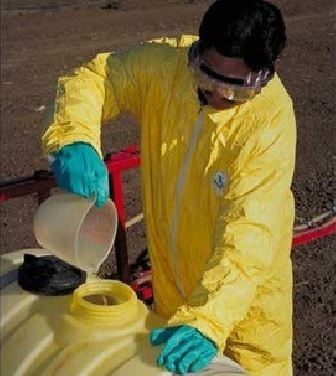National Poison Prevention Week was March 19-25, 2017.
According to the Centers for Disease Control and Prevention (CDC), poisoning is the number one cause of injury-related death in the United States, and 1073 people in California were poisoned by pesticides in 2014 alone. Each year since 1962, National Poison Prevention Week has taken place during the third week of March, to raise awareness about avoiding these tragedies. No one wants their workers or family members to experience illness or death from pesticide exposure, so the UC IPM Pesticide Safety Education Program (PSEP) would like to bring special attention to preventing pesticide poisoning this week. The program also published a new edition of The Safe and Effective Use of Pesticidesin 2016, which contains a wealth of pesticide safety and hazard prevention information for people who work with pesticides.
Both agricultural and household pesticides can poison people if they are not properly handled. In agriculture, poisoning most often results from pesticide mixing and loading, and the most harm occurs due to spills, splashes and equipment failure. In the home, many pesticide poisoning incidents involve children swallowing pesticides, including garden products, disinfectant cleaners, or other chemicals used to control pests.
One of the most important things you can do to prevent pesticide poisoning is to follow the instructions on the pesticide label. Labels address critical information about how to use a pesticide safely, including the kind of personal protective equipment (PPE) you should wear to prevent overexposure, how much of the product to apply, the minimum time you must wait to enter the area after applying the pesticide (the restricted entry interval), and the minimum time that must pass between application and harvest (preharvest interval).
Labels also include important signal words such as “Danger,” “Warning,” or “Caution” that indicate how acutely toxic the chemical is to humans, as well as directions to avoid pesticide contamination of sensitive areas such as schools and hospitals. These instructions are meant to protect anyone who is at risk of being exposed to hazardous pesticide residues. It is essential to thoroughly read and understand the pesticide label before working with the pesticide, and to carefully comply with label instructions throughout the process. The UC IPM guide to Understanding Pesticide Labels for Making Proper Applications can help you do this, and is available in both English and Spanish.
If you apply pesticides in or around your home, be sure to store them properly and keep them out of the reach of children. Keep in mind that even mothballs may look like candy to very young children. It is illegal and unsafe to store pesticides in food or drink containers, which can easily fool people into consuming them and being poisoned. According to the California Department of Pesticide Regulation, these mistakes caused 62 incidents of child poisoning from pesticide ingestion in California in 2014, and 47 of those cases involved children under six years of age.
To learn more about poisoning and how to prevent it, consider visiting the following resources:
Center for Disease Control and Prevention Leading Causes of Death Reports
National Poison Prevention Week website
National Pesticide Information Center
UC IPM online course: Proper Pesticide Use to Avoid Illegal Residues

If you apply pesticides anywhere outside of the home and garden, or if you work in areas where pesticides are applied, you must also comply with the annual training and certification requirements listed in CCR 6724 and 6764 (links below). Pesticide handler and fieldworker training helps prevent pesticide hazards and poisoning. This blog post cannot be used as a substitute for required training.
http://www.cdpr.ca.gov/docs/legbills/calcode/030302.htm#a6738
http://www.cdpr.ca.gov/docs/legbills/calcode/030302.htm#a6724
http://www.cdpr.ca.gov/docs/legbills/calcode/030303.htm#a6764
Posted by Stephanie Parreira on May 25, 2017 at 3:50 PM